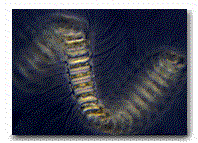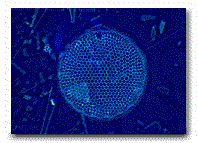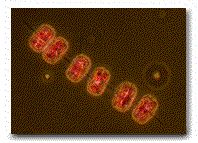![]()
Science
advisor: Dr. Carina Lange (undergoing first
revisions)
Associate
Researcher
Specialty: Diatoms
![]() iatoms
are one of the key marine organisms that play the role
of grass in
the ocean.
iatoms
are one of the key marine organisms that play the role
of grass in
the ocean.
Although diatoms are as abundant in the ocean as grass is on land, very
few people have seen them, so let's first take a look at a few of these
tiny yet abundant beauties. These photographs were taken by marine biologists
Dr. Carina Lange and Dr. Elizabeth Venrick at Scripps Institution of Oceanography.



![]()
Diatoms play a very important role in modern earth systems due to their great abundance and the nature of their activities. Their role in earth systems will be the focus of our journey. We'll see how the delicate beauty of individual shells belie the collective strength of these organisms to influence earth systems, and how fossil diatoms can speak to us from the past, telling us about the climates of past worlds.
How do diatoms influence earth systems? Both grasses and diatoms possess the special ability to convert sunlight and nutrients into living matter through the process of photosynthesis. As you've learned before, sunlight is the primary source of energy for life, whether on land or in the ocean. However, only photosynthetic organisms at the base of the trophic pyramid can directly capture the sun's energy. Organisms that sit at all trophic levels above the base must acquire this energy indirectly by consuming food, or to put it bluntly, by eating other organisms. Like grass, diatoms perform the essential task of introducing the sun's energy into ecosystems and they are the staple food of many other organisms.
From a research perspective, it's important to know how diatoms are distributed in the ocean. We saw that the density of terrestrial plants is not uniform across North America. This is also true for the oceans. What does the ocean productivity pattern look like? We'll see how SeaWiFS researchers use satellites to estimate the distribution of primary producers in the ocean. People want to know this distribution because the total abundance of marine life is dependent on the abundance of primary producers such as diatoms. The more diatoms there are, the more squid, fish, and whales can be supported. Whether to feed the body or the soul, people are keenly interested in the abundance of life in the oceans.
What determines the number of primary producers that can be supported within a particular ecosystem? It's important to understand how environmental factors set the abundance of diatoms from place-to-place and over time. Abundance is heavily dependent on the ability of ecosystems to provide necessary resources such as water, carbon dioxide, nutrients, and sunlight. In the ocean, water and carbon dioxide are plentiful and do not limit growth. However, sunlight and nutrients are limiting, being distributed unevenly across the oceans. Just like grass, primary producers such as diatoms tend to grow most abundantly where it's sunny and fertile. Due to major environmental differences between ocean and land, grass is a minor player in the oceans where diatoms thrive. As nature and humans change their world, how will the distribution of diatoms and their interdependents change? These are the questions driving research today and we'll visit a few examples.
So let's enter the world of diatoms…

